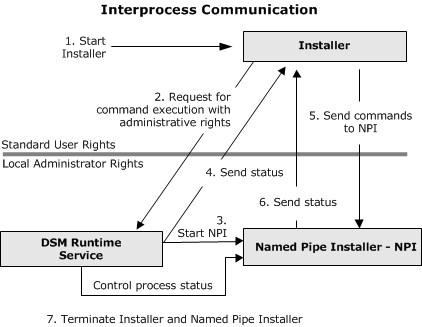DSM Management Services
Constituent elements of DSM Management Services
The DSM Management Services are a collection of services of the common infrastructure of the DSM modules (shared infrastructure).
These services include:
These services have a common basis, the Management Agent Framework. This serves as host for different DSM background processes and functions based on Windows services. These services are also referred to as Management Extensions.
DSM Core Service 
After a managed computer starts up, the DSM Core Services are automatically started as the first component of DSM Client. The DSM Core Services group together a number of services whose job is to ascertain or provide essential information on the operation of the DSM Client.
The DSM Core Services provide the following functions:
- Recognition of
changes in the network state - online via LAN, online via RAS, offline
(Net State)
Depending on the network state, certain settings can be changed and actions performed. - Access to the Infrastructure
Configuration Database (ICDB Access)
Determines the location of the managed computer in the site structure and makes this information available. - Synchronization
between the DSMDB Cache of a managed computer and the DSMDB (DSMDB
Cache Manager)
The DSMDB Cache contains configuration data from the DSMDB which is relevant to the managed computer concerned (e.g. policies and policy instances). - Execution
of all kinds of jobs (Local Job Manager)
Jobs are created by different DSM modules and sent to the Local Job Manager for execution. These include download jobs, for example. - Distribution and update of the components of the DSM Client (Client State Manager)
- Alignment of the
local Repository Cache with the relevant depot (Repository
Cache Manager)
The Repository Cache provides installation data (bulk data) relating to packages locally for the installation (staging). - Determination of
policies that are relevant to the managed computer (Client
Management Server)
(starting from user and group membership according to the directory service) - Determination of the basic inventory data of a managed computer
Basic inventory data is used to identify a managed computer. This data includes, for example, the name of the computer and the MAC address. - Connection of additionally configured network drives
DSM Runtime Service 
On managed computers the DSM Runtime Service is started after the DSM Core Services have successfully started up, but before a user of the DSM Runtime Service has logged on.
Users can only install software if they have adequate rights. Copying files to the Windows or System directory, for example, require rights generally held only by an administrator. This means that logged-on users cannot normally install software themselves on their computers.
DSM uses the DSM Runtime Service for allowing software to be installed under a user account having normal rights. The DSM Runtime Service uses an account with local administrator rights and assumes the execution of those commands that cannot be executed with the rights of the user account.
The DSM Runtime Service does not perform the installation itself; instead, it uses a second instance of the Installer, the Named Pipe Installer (NPI). The NPI takes its (extended) user rights from the DSM Runtime Service that was granted these rights on the basis of its configured local administrator account.
